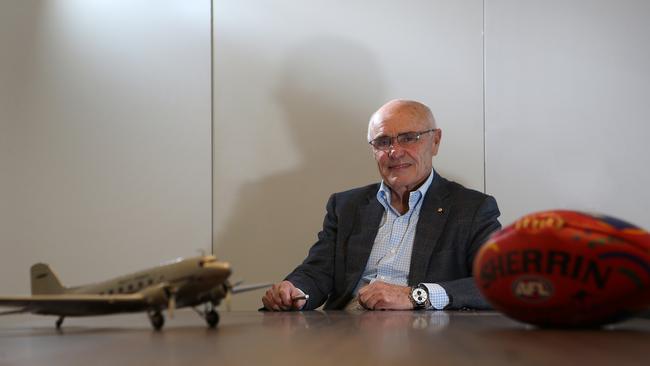How Essendon has bounced back from drug-scandal era financial losses
The dark times appear to be over for the Bombers, at least as far as the bottom line is concerned. Here’s how the club got back to making money after the drugs saga — and how it’s spending its profits.

Business
Don't miss out on the headlines from Business. Followed categories will be added to My News.
Despite only a very minor role in the finals series, last year was a benchmark one for Essendon.
The drugs scandal which has afflicted the club had its biggest financial impact in the 2016 year when the club made a $9.8 million loss.
About $4.5 million was in compensation and legal costs, and another $4.6 million in one-off expenses due to the scandal.
But a look at the accounts shows a club that seems to be getting it mojo back — at least in a financial sense.
In a flourish last year, Essendon cleared its debts, invested in the redevelopment of its “Hangar” headquarters and attracted record membership numbers.
‘What drug scandal?’ you might hear them say as it became debt free for the first time since 2011.
WHERE DOES ESSENDON GET ITS CASH?
The profit last year of $3.5 million was the third in a row for the club.
But that profit was bolstered by a major fundraising campaign the club started in 2017 that aims at tapping its big end of town supporters.
In the last year they tipped in $3.474 million alone for the Hangar redevelopment.
The previous year – 2018 – saw a profit of $2.3 million, with donations of $1 million.
In 2017 it received $4.1 million in donations and made a profit of $5.1 million.

It seems to have been a smart strategic move which has allowed it to reinvest in facilities at a time when it has been focused on getting things back on track.
Despite working class roots, the club has some of the wealthiest fans in footyland.
Most notably rich-lister and well known philanthropists Paul Little – with wealth valued at $950 million – helped lead the club during the dark days of the drugs scandal.
But it can’t be all put down to donations.
The Dons do manage to rake in a lot of cash.
The crucial Essendon fans played a strong role.

The Dons scraped into the finals but despite the lack of real on field success hit an all-time membership record passing the 80,000-member mark for the first time in the club’s history in June.
The final tally at 84,567 up from 79,318 the year before.
This brought in $14.2 million in revenue, up from $13.8 million in 2018.
More controversially, the club still has a strong suite of pokies.
It made pokies revenue from its Windy Hill Venue and Melton Country Club.
This came in at $7.9m
From these venues it made $4.9m from food sales.
The club received AFL distribution revenue of $12 million, which was similar to the year before.
The club also has strong sponsor deals with Fujitsu Australia, Amart Furniture and Under Armour.
The revenue of the club hit $69m last year compared to $65m the year before.
Its conservative fiscal approach (helped buy those wealthy donors) saw debt paid down and the net assets of the club increased to $39.6 million. This is compared to $36.1 million in 2018.
WHAT DOES IT COST TO RUN ESSENDON?
In the last year the cost of putting Essendon teams on the field increased by about a million dollars to $26.6 million.
The club’s “marketing expenses” also rose by a million dollars to $9.5 million.
But clearly a big expense is the redevelopment of the club’s Hangar headquarters.
Works are underway on the second stage of the expansion.
The clubs annual report reveals an additional $7.6 million was received during the year for the development.

These included the donations from fans but also a Federal Government grant of $4 million to be applied to additional facilities to be shared with the Paralympics Australia.
Amounts pledged to date in relation to the project total $13.3 million.
Construction on the project has commenced, with expenditure to date amounting to $1.3 million.
Essendon expects The Hangar project to be completed by 2021 to align with its celebration of the 150th year of the Club.
WHAT DANGERS COULD THE DONS FACE?
Dons fans have been very patient — and generous — over the last seven years and this has kept the club humming along.
But it needs to keep the cash coming in to fund its ambitions.
A headwind could possibly be the increased focus and pressure on clubs offloading pokie income.
Clubs like the Pies and Geelong show this can be done though, without seemingly hurting the bottom line.
While the club is not only debt free it has a cash balance of $6.3 million.
But its own report envisages it going back into debt this year.
“Construction of the (Hangar) expansion is now commencing in earnest, which will see us accessing our borrowing facilities in 2020,” it says.
The club has available $11.85 million of bank finance facilities, with about $8m available from NAB and $3.8 million from Bendigo Bank.
READ MORE:
WHY IS DANIHER HEADED OVERSEAS?
SUPERCOACH FORM GUIDE: BOMBERS
None of these had been drawn down at October last year.
“We expect our cash flows to remain high and allow us to comfortably service this debt and repay it within a reasonable time frame.”
The Dons need to ensure that as they draw debt they keep those record number of fans signing up and deep pocketed donors stay onside.
